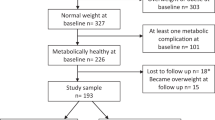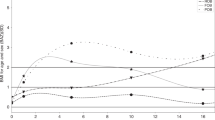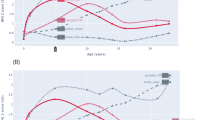Abstract
Objective:
Not all overweight and obese individuals appear to be at equal risk of developing metabolic abnormalities. We sought to examine the effect of factors from different stages of life on risk of metabolic abnormalities at age 50 years in overweight and obese adults.
Design and subjects:
Longitudinal study of all persons born in Newcastle upon Tyne, UK in May and June 1947 and followed to age 50 years when a clinical examination took place and a detailed questionnaire on health and lifestyle was completed. Participants in this study (n=223) were those defined as being overweight or obese with a body mass index (BMI) greater than or equal to 25 at age 50 years. Subjects were defined as ‘metabolically normal’ if they had normal lipids, glucose and blood pressure.
Results:
Lower BMI was the strongest predictor of remaining metabolically normal in both men and women. After adjusting for BMI, lower levels of cigarette smoking and higher levels of physical activity were independently associated with being metabolically normal in men. No other factors were independently associated with being metabolically normal in women. A stronger inverse relationship between BMI and metabolic status was found in men (Odds ratio (OR) per unit increase in BMI=0.65, 95% confidence intervals (95% CI) 0.52–0.81) than in women (OR=0.90, 95% CI 0.82–0.99). No association was seen for factors operating in fetal, infant and childhood life.
Conclusions:
Adult factors made a greater contribution to remaining metabolically normal than birth or childhood factors in this sample of overweight and obese adults. A lower adult BMI appeared to reduce the risk in men and women and lower cigarette smoking and higher level of physical activity also independently reduced the risk in men. Public health policy to reduce the burden of morbidity associated with obesity should continue to encourage weight loss, physical activity and smoking cessation.
This is a preview of subscription content, access via your institution
Access options
Subscribe to this journal
Receive 12 print issues and online access
$259.00 per year
only $21.58 per issue
Buy this article
- Purchase on Springer Link
- Instant access to full article PDF
Prices may be subject to local taxes which are calculated during checkout
Similar content being viewed by others
References
Abate N . Obesity and cardiovascular disease – pathogenetic role of the metabolic syndrome and therapeutic implications. J Diabetes Complications 2000; 14: 154–174.
Must A, Spadano J, Coakley EH, Colditz G, Dietz WH . The disease burden associated with overweight and obesity. JAMA 1999; 282: 1523–1529.
Reaven GM . Role of insulin resistance in human disease. Diabetes 1988; 37: 1595–1607.
Vague J . The degree of masculine differentiation of obesities: a factor determining predisposition to diabetes, atherosclerosis, gout and uric calculus disease. Am J Clin Nutr 1956; 4: 2–34.
Ruderman N, Chisholm D, Pi-Sunyer X, Schneider S . The metabolically obese, normal-weight individual revisited. Diabetes 1998; 47: 699–713.
Dvorak RV, De Nino WF, Ades PA, Poehlman ET . Phenotypic characteristics associated with insulin resistance in metabolically obese but normal-weight young women. Diabetes 1999; 48: 2210–2214.
Barker DJP . The developmental origins of adult disease. Eur J Epidemiol 2003; 18: 733–736.
Kuh DL, Ben Shlomo Y . A Life Course Approach to Chronic Disease Epidemiology. Oxford University Press: Oxford, 1997.
Spence J, Walton WS, Miller FJW, Court SDM . A Thousand Families in Newcastle upon Tyne. Oxford University Press: London, 1954.
Lamont DW, Parker L, Cohen MA, White M, Bennett SM, Unwin NC et al. Early life and later determinants of adult disease: a 50 year follow-up study of the Newcastle Thousand Families cohort. Public Health 1998; 112: 85–93.
Lamont D, Parker L, White M, Unwin N, Bennett SMA, Cohen M et al. Risk of cardiovascular disease measured by carotid intima-media thickness at age 49–51: lifecourse study. BMJ 2000; 320: 273–278.
Parker L, Lamont DW, Unwin N, Pearce MS, Bennett SMA, Dickinson HO et al. A lifecourse study of risk for hyperinsulinaemia, dyslipidaemia and obesity (the central metabolic syndrome) at age 49–51 years. Diabetes Med 2003; 20: 406–415.
Matthews DR, Hosker JP, Rudenski AS, Naylor BA, Treacher DF, Turner RC . Homeostatis model assessment: insulin resistance and beta-cell function from fasting plasma glucose and insulin concentrations in man. Diabetologia 1985; 28: 412–419.
Leon DA, Lithell HO, Vagero D, Koupilova I, Mohsen R, Berglund L et al. Reduced fetal growth rate and increased risk of death from ischaemic heart disease: cohort study of 15000 Swedish men and women born 1915–29. BMJ 1998; 317: 241–245.
Power C, Rodgers B, Hope S . U-shaped relation for alcohol consumption and health in early adulthood and implications for mortality. Lancet 1998; 352: 877.
Bingham SA, Gill C, Welch A, Cassidy A, Runswick SA, Oakes S et al. Validation of dietary assessment methods in the UK arm of EPIC using weighed records, and 24-hour urinary nitrogen and potassium and serum vitamin C and carotenoids as biomarkers. Int J Epidemiol 1997; 26: S137–S151.
Kuh DJL, Cooper C . Physical activity at 36 years: patterns and childhood predictors in a longitudinal study. J Epidemiol Commun Health 1992; 46: 114–119.
Carey VJ, Walters EE, Colditz GA, Solomon CG, Willett WC, Rosner BA et al. Body fat distribution and risk of non-insulin-dependent diabetes mellitus in women; The nurses health study. Am J Epidemiol 1997; 145: 614–619.
Despres JP, Moorjani S, Lupien PJ, Tremblay A, Nadeau A, Bouchard C . Regional distribution of body fat, plasma lipoproteins, and cardiovascular disease. Arteriosclerosis 1990; 10: 497–511.
Abate N, Garg A, Peshock RM, Stray-Gundersen J, Grundy SM . Relationships of generalized and regional adiposity to insulin sensitivity in men. J Clin Invest 1995; 96: 88–98.
Nieves DJ, Cnop M, Retzlaff B, Walden CE, Brunzell JD, Knopp RH et al. The atherogenic lipoprotein profile associated with obesity and insulin resistance is largely attributable to intra-abdominal fat. Diabetes 2003; 52: 172–179.
Andersen LF, Nes M, Lillegaard IT, Sandstad B, Bjorneboe GE, Drevon CA . Evaluation of a quantitative food frequency questionnaire used in a group of Norwegian adolescents. Eur J Clin Nutr 1995; 49: 543–554.
Pietinen P, Hartman AM, Haapa E, Rasanen L, Haapakoski J, Palmgren J et al. Reproducibility and validity of dietary assessment instruments. I. A self-administered food use questionnaire with a portion size picture booklet. Am J Epidemiol 1988; 128: 655–666.
Dzien AC, Dzien-Bischinger C, Hoppichler F, Lechleitner M . The metabolic syndrome as a link between smoking and cardiovascular disease. Diabetes, Obes Metab 2004; 6: 127–132.
Geslain-Biquez C, Vol S, Tichet J, Caradec A, D'Hour A, Balkau B . The metabolic syndrome in smokers. The D.E.S.I.R. study. Diabetes Metab 2003; 29: 226–234.
Greenfield JR, Samaras K, Jenkins AB, Kelly PJ, Spector TD, Campbell LV . Moderate alcohol consumption, estrogen replacement therapy, and physical activity are associated with increased insulin sensitivity. Diabetes Care 2003; 26: 2734–2740.
Acknowledgements
We thank all the Thousand Family Study members for taking part, the study teams past and present and the Wellcome Trust, the Minnie Henderson Trust, the Sir John Knott Trust and the Special Trustees of the Newcastle Hospitals for funding. EPIC food frequency questionnaires were analysed by the MRC Dunn Clinical Nutrition Centre, Cambridge. The principal investigators on the 50-year follow-up were Professor Sir George Alberti, Professor Sir Alan Craft and Professor Louise Parker. The clinical examinations were supervised by Dr Stuart Bennett and performed by our research nurses Jan Gebbie and Jean Gerrard.
Author information
Authors and Affiliations
Corresponding author
Rights and permissions
About this article
Cite this article
Hayes, L., Pearce, M. & Unwin, N. Lifecourse predictors of normal metabolic parameters in overweight and obese adults. Int J Obes 30, 970–976 (2006). https://doi.org/10.1038/sj.ijo.0803213
Received:
Revised:
Accepted:
Published:
Issue Date:
DOI: https://doi.org/10.1038/sj.ijo.0803213
Keywords
This article is cited by
-
Prevalence rate of Metabolic Syndrome in a group of light and heavy smokers
Diabetology & Metabolic Syndrome (2013)
-
Impact of early psychosocial factors (childhood socioeconomic factors and adversities) on future risk of type 2 diabetes, metabolic disturbances and obesity: a systematic review
BMC Public Health (2010)
-
Sujets « métaboliquement sains », bien qu’obèses. Deuxième partie : pronostic et prise en charge
Obésité (2009)
-
Sujets « métaboliquement sains », bien qu’obèses. Première partie: diagnostic, physiopathologie et prévalence
Obésité (2009)
-
Perturbed Autonomic Nervous System Function in Metabolic Syndrome
NeuroMolecular Medicine (2008)



